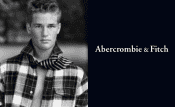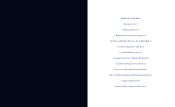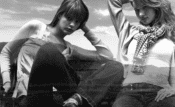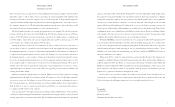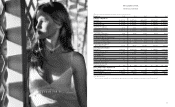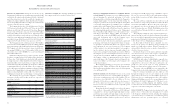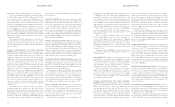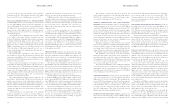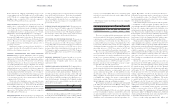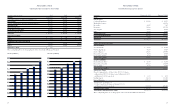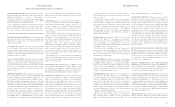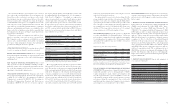Abercrombie & Fitch 2004 Annual Report Download - page 8
Download and view the complete annual report
Please find page 8 of the 2004 Abercrombie & Fitch annual report below. You can navigate through the pages in the report by either clicking on the pages listed below, or by using the keyword search tool below to find specific information within the annual report.
Abercrombie &Fitch
RESULTS OF OPERATIONS During the 2004 fiscal year, the
Company made solid progress in executing its strategic priority to build
and maintain the aspirational positioning of its brands. An integral
part of this strategy was to reduce the overall level of promotions to
emphasize the superior quality of its brands. In addition, the Company
increased its spending in its retail stores to improve the overall customer
experience and reduce the level of shrink.
The Company had net sales of $2.021 billion in fiscal 2004, up
18.3% versus net sales in the fiscal 2003 period. Net income was $216.4
million in fiscal 2004, up 5.7% versus the 2003 fiscal year. Operating
income for the 2004 fiscal year increased 5.0% to $347.6 million
from $331.2 million for the 2003 fiscal year. Operating income
included a $40.9 million accrual for the expected settlement of three
related class action employment discrimination lawsuits. Net income
per weighted-average diluted share was $2.28 for the 2004 fiscal year
compared to $2.06 in the 2003 fiscal year, an increase of 10.7%.
The Company generated cash from operations of $426.1 million
in fiscal 2004 versus $342.5 million in fiscal 2003 resulting primarily
from strong earnings coupled with disciplined inventory management.
The Company used cash from operations to finance its growth strat-
egy, opening 84 Hollister stores, 16 Abercrombie & Fitch stores, 9
abercrombie stores and 4 RUEHL stores, and remodeling 14
Abercrombie & Fitch stores.
Further, the Company used excess cash to repurchase 11.2 mil-
lion shares of common stock for $434.7 million and pay dividends of
$0.50 per share. Cash distributions to shareholders will continue to
be an important way to deliver shareholder value, but the Company’s
first priority will be to invest in the business to support its domestic
and international growth plans. Further, the Company is committed
to maintaining sufficient cash on the balance sheet to support the
needs of the business and withstand unanticipated business volatility.
Therefore, the Company plans to retain approximately $300 to $350
million of cash and marketable securities, subject to a variety of factors
including inventory purchases and the timing of certain payments.
The following data represent the Company’s consolidated
statements of income for the last three fiscal years, expressed as a
percentage of net sales:
2004 2003 2002
Net Sales 100.0% 100.0% 100.0%
Cost of Goods Sold, Occupancy
and Buying Costs 55.0 58.0 58.9
Gross Income 45.0 42.0 41.1
General, Administrative
and Store Operating Expenses 27.8 (1) 22.6 21.5
Operating Income 17.2 19.4 19.6
Interest Income, Net (0.3) (0.2) (0.2)
Income Before Income Taxes 17.5 19.6 19.8
Provision for Income Taxes 6.8 7.6 7.6
Net Income 10.7 12.0 12.2
(1) Includes 2.0% related to the settlement of the class action diversity lawsuits.
FINANCIAL SUMMARY The following summarized operational
data compares fiscal 2004 to fiscal 2003 and fiscal 2002:
% Change
2003- 2002-
2004 2003 2002 2004 2003
Net sales (thousands) $2,021,253 $1,707,810 $1,595,757 18% 7%
Net sales by brand
Abercrombie & Fitch $1,210,222 $1,180,646 $1,238,498 3% (5)%
abercrombie $ 227,204 $ 212,276 $ 207,537 7% 2%
Hollister $ 579,687 $ 314,888 $ 149,722 84% 110%
RUEHL* $ 4,140 ————————
Increase (decrease) in
comparable store sales
Abercrombie & Fitch (1)% (11)% (6)%
abercrombie 1% (6)% (4)%
Hollister 13% 7% 10%
Retail sales increase attributable
to new and remodeled stores,
magazine, catalogue and web sites 16% 16% 22%
Retail sales per average
gross square foot
Abercrombie & Fitch $ 352 $ 358 $ 407 (2)% (12)%
abercrombie $ 282 $ 270 $ 286 4% (6)%
Hollister $ 423 $ 404 $ 385 5% 5%
RUEHL* $ 136 ————————
Retail sales per average
store (thousands)
Abercrombie & Fitch $ 3,103 $ 3,184 $ 3,652 (3)% (13)%
abercrombie $ 1,241 $ 1,194 $ 1,271 4% (6)%
Hollister $ 2,740 $ 2,594 $ 2,450 6% 6%
RUEHL* $ 1,255 ————————
Sales statistics per average store
Number of transactions
Abercrombie & Fitch 45,941 51,234 59,832 (10)% (14)%
abercrombie 21,740 22,128 23,210 (2)% (5)%
Hollister 56,687 57,593 58,648 (2)% (2)%
RUEHL* 12,913 ————————
Average transaction value
Abercrombie & Fitch $ 67.54 $ 62.15 $ 61.04 9% 2%
abercrombie $ 57.10 $ 53.98 $ 54.77 6% (1)%
Hollister $ 48.33 $ 45.04 $ 41.78 7% 8%
RUEHL* $ 97.16 —— ——————
Units per transaction
Abercrombie & Fitch 2.22 2.24 2.22 (1)% 1%
abercrombie 2.68 2.68 2.70 —— (1)%
Hollister 2.18 2.14 2.00 2% 7%
RUEHL* 2.17 —— —— ————
Average unit value
Abercrombie & Fitch $ 30.42 $ 27.75 $ 27.50 10% 1%
abercrombie $ 21.31 $ 20.14 $ 20.29 6% (1)%
Hollister $ 22.17 $ 21.05 $ 20.89 5% 1%
RUEHL* $ 44.77 —— —— —— ——
* Net sales for RUEHL, and the related statistics, reflect the activity of three stores opened
in September 2004 and one store opened in December 2004.
FISCAL 2004 COMPARED TO FISCAL 2003: CURRENT TRENDS
AND OUTLOOK The Company’s focus is on building, maintain-
ing and managing the aspirational positioning of its brands.
Management believes that this strategy will allow the Company to
maintain high margins over the long-term while driving the
Company’s growth in sales and profits through the development
of new brands. Management expects Hollister to be a significant
growth vehicle for the Company domestically, while it continues to
differentiate the Abercrombie & Fitch brand from the competition
by emphasizing high-quality and fashion content. Management
believes that Abercrombie & Fitch’s success will continue to favor-
ably impact abercrombie’s business. While the Company is
encouraged by the results of the RUEHL launch, the brand is still
in its early development and as such the Company expects
RUEHL to sustain operating losses in 2005 and 2006.
In order to achieve and, thereafter, maintain the aspirational
positioning of the brands, the Company will continue to manage
its expenditures to maintain and enhance the current store base
and complement the new stores being opened. The Company
will also continue its store investment program to focus on improv-
ing the customer’s in-store experience through enhanced cus-
tomer service and improved merchandise presentation. Further,
the Company expects to invest in higher inventories to ensure in-
stock size and color assortments. While these initiatives will increase
the Company’s selling costs, management believes the enhanced
aspirational image of the Company’s brands and improved cus-
tomer service will have a positive impact on the Company’s sales
and profit performance.
The Company is planning to open up to five stores in Canada
during fiscal 2005. Further, in February 2005, the Company estab-
lished two European subsidiaries that are expected to begin opening
stores in Europe by 2006.
FOURTH QUARTER 2004: NET SALES Net sales for the fourth
quarter of the 2004 fiscal year were $687.3 million, up 22.6% ver-
sus last year’s fourth quarter net sales of $560.4 million. The net
sales increase was attributable to the net addition of 88 stores
during the 2004 fiscal year, a comparable store sales increase of
9% for the quarter and an increase in the direct-to-consumer
business net sales of $11.1 million versus the comparable period
in the 2003 fiscal year.
By merchandise brand, comparable store sales for the quarter
were as follows: Abercrombie & Fitch increased 4% with men’s
comparable store sales increasing by a high-single digit percentage
and women’s increasing by a low-single digit percentage. abercrom-
bie, the kids’ business, achieved a 16% increase in comparable store
sales with girls attaining a high-teen positive increase and boys
increasing by a low double-digit percentage. In Hollister, compara-
ble store sales increased by 19% for the fourth quarter with guys
posting a high-teen increase and girls realizing an increase in the
low-twenties.
On a regional basis, comparable store sales results across all
three brands were strongest along the East Coast and in the West
and weakest in the Midwest. However, all regions reported posi-
tive comparable store sales for the quarter. Stores located in New
York City metropolitan area, Florida, Philadelphia metropolitan
area and Southern California had the best comparable store sales
performance.
The Company committed to a more aspirational and less pro-
motional strategy in early 2004 which it maintained throughout
the year. As such, the Company did not anniversary the direct mail
promotions used during the fourth quarter of the 2003 fiscal year
to drive business between Thanksgiving and Christmas.
In Abercrombie & Fitch, the men’s comparable store sales
increase for the quarter was driven by strong performances in
graphic tees, denim, and woven shirts. Women’s comparable store
sales growth was driven by an increase in polos, denim and fleece,
offset by a decrease in sweaters.
In the kid’s business, for the quarter, girls had comparable
store sales increases across most of the categories, especially polos,
denim and graphic tees. Boys’ comparable store sales increase was
driven by graphic tees, denim and fleece.
In Hollister, girls achieved a slightly higher comparable store
sales increase than guys. In girls, polos, denim and fleece had strong
comparable store sales increases. The increase in the guys’ com-
parable store sales was the result of a strong performance in
graphic tees, denim and woven shirts categories for the quarter.
The impact of the four RUEHL stores was immaterial to the
Company’s total net sales for the fourth quarter of the 2004 fiscal year.
Direct-to-consumer merchandise net sales, which are sold
through the Company’s web sites and catalogue, in the fourth
quarter of the 2004 fiscal year, were $40.1 million, an increase of
29.4% versus last year’s fourth quarter net sales of $31.0 million.
Shipping and handling revenue for the corresponding periods was
$5.5 million in 2004 and $3.5 million in 2003. The direct-to-con-
sumer business, including shipping and handling revenue,
accounted for 6.6% of net sales in the fourth quarter of fiscal 2004
compared to 6.2% in the fourth quarter of fiscal 2003.
GROSS INCOME The Company’s gross income may not be com-
parable to those of other retailers since all significant costs related
to the Company’s distribution network, excluding direct shipping
costs related to direct-to-consumer sales, are included in general,
administrative and store operating expenses (see “General,
Abercrombie &Fitch
12 13
MANAGEMENT’S DISCUSSION AND ANALYSIS


